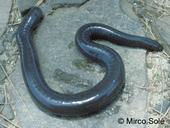|
Chthonerpeton indistinctum (Reinhardt & Lütken, 1862)
Argentine caecilian | family: Typhlonectidae genus: Chthonerpeton |
| Species Description: Reinhardt, J. T., and Lütken, C. F. (1862 "1861"). Bidrag til Kundskab om Brasiliens Padder og Krybdyr. Förste Afdeling: Padderne og Öglerne. Videnskabelige Meddelelser fra Dansk Naturhistorisk Forening i Kjøbenhavn, Serie 2(3), 143–242. | |
|
Etymology: Species name originates from Latin “indistinctus”, meaning "obscure or dim". This likely refers to the species’ black coloration or indistinct annuli (Gudynas and Williams 1992). |
|
 © 2003 Mirco Sole (1 of 3) |
|
|
|
Description This species may be confused for congenerics but can be easily differentiated via locality and primary annuli number. As of 2025, this is the only Chthonerpeton species to occur outside of Brazil other than C. onorei, which is only found in northeastern Ecuador. It is characterized by its stocky body, wide head, and superficial choanal valves. Many characters can be compared to differentiate C. indistinctum from similar species such as C. braestrupi, C. exile, C. noctinectes, and C. perissodus (Gudynas et al. 1988, da Silva et al. 2003). Specifically, C. indistinctum is distinguishable by its 82 - 86 vertebrae and 70 - 81 primary annuli, which are fewer than C. noctinectes (100 - 108 vertebrae, 94 -103 primary annuli), C. perissodus (103 - 108 vertebrae, 95 - 101 primary annuli), and C. exile (99 vertebrae, 88 primary annuli). Additionally, C. indistinctum has fewer premaxillary-maxillary teeth (37) than C. perissodus (41 - 46). Lastly, C. indistinctum’s dark coloration can be used to easily distinguish the species from C. braestrupi, which is bicolor with a dark dorsum and cream venter (Nussbaum and Wilkinson 1987). In life, dorsal coloration of C. indistinctum is bright black, while the ventral coloration is black-gray. The entire body contains small white spots, which are thought to be mucous gland apertures. The tentacle and eye are additionally surrounded by a white coloration, which may be solid or diffused depending on the individual. The area surrounding the vent is cream-white (Gudynas and Williams 1992). There is variation on an individual level with some individuals having solid versus diffused white coloration around the tentacle and eye. Additionally, sexual dimorphism has been observed with males having larger vents and body width at the cloaca (Gudynas et al. 1988). Distribution and Habitat Country distribution from AmphibiaWeb's database: Argentina, Brazil, Paraguay, Uruguay
Life History, Abundance, Activity, and Special Behaviors The gestation period for the species is thought to be four months, with a single female birthing 6 - 10 newborns. Copulation is in the austral spring, from August through September (Gudynas et al. 1988). A study that revised the stomach contents in 17 specimens revealed insight into the diet, which includes arachnids, odonata larvae, and other amphibians. They are also known to have nematodes, likely parasitic, in their digestive tract (Gudynas et al. 1988). Larva Comments References Gudynas, E., and Williams, J.D. (1992). Chthonerpeton indistinctum (Reinhardt and Lütken). Catalogue of American Amphibians and Reptiles. Society for the Study of Amphibians and Reptiles, 531.1-531.2. [link] Gudynas, E., Williams, J. D., and de las Mercedes Azpelicueta, M. (1988). Morphology, ecology and biogeography of the South American caecilian Chthonerpeton indistinctum (Amphibia: Gymnophiona: Typhlonectidae). Zoologische Mededelingen, 62(2), 5–28. [link] Maciel, A. O., Leite, J. M., Leite, R. R., Leite, J. R., and Cascon, P. (2015). A new species of Chthonerpeton Peters 1880 (Amphibia: Gymnophiona: Typhlonectidae) from the State of Piauí, Northeastern Brazil. Journal of Herpetology, 49(2), 308–313. [link] Nussbaum, R. A., and Wilkinson, M. (1987). Two new species of Chthonerpeton (Amphibia: Gymnophiona: Typhlonectidae) from Brazil. Occasional Papers of the Museum of Zoology, University of Michigan, 716, 1–15. [link]
Originally submitted by: Franziska Sandmeier (first posted 2001-02-23) Description by: Fede KG (updated 2025-03-03)
Distribution by: Fede KG (updated 2025-03-03)
Life history by: Fede KG (updated 2025-03-03)
Larva by: Fede KG (updated 2025-03-03)
Comments by: Fede KG (updated 2025-03-03)
Edited by: JG (fixing maps 7/25/01), Ann T. Chang (2025-03-27) Species Account Citation: AmphibiaWeb 2025 Chthonerpeton indistinctum: Argentine caecilian <https://amphibiaweb.org/species/1953> University of California, Berkeley, CA, USA. Accessed May 13, 2025.
Feedback or comments about this page.
Citation: AmphibiaWeb. 2025. <https://amphibiaweb.org> University of California, Berkeley, CA, USA. Accessed 13 May 2025. AmphibiaWeb's policy on data use. |



 Map of Life
Map of Life